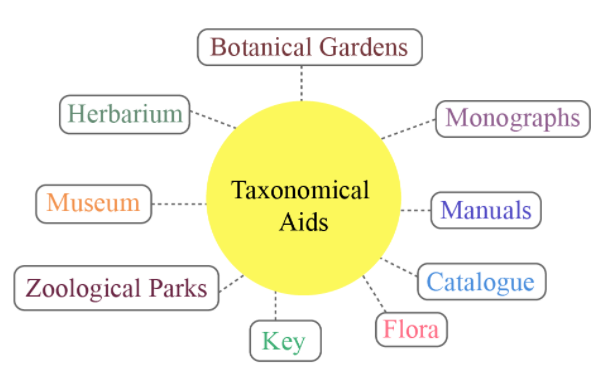-
Call Now
1800-102-2727
Herbarium
Introduction
- Taxonomic aid is defined as the techniques, stored information and the procedure which are required in the identification and classification of organisms.
- The first herbarium was developed by a professor of botany Luca Ghini at Pisa in Italy.
- This information helps in the studies of various species of plants, animals and other organisms which will be further helpful in agriculture, forestry, industry etc.
- Some different types of taxonomical aids offered by various biologists are herbarium, botanical gardens, zoological parks, museums, keys (analytical device), flora, manuals, monographs and catalogues.

Definition:
- Herbarium is a kind of repository or storehouse of collected specimens of plants that are usually dried, pressed and preserved on sheets.

Detailed explanation :
Herbarium technique
This technique includes the following steps -
(a). Collection of the specimen (plants).
- The collection of the flora (plants) should be done very carefully using a scientific mind.
- The plant parts should be collected in such a way that it should provide the full information and diseased plant parts must be avoided.
- Tools required for the collection and preservation of plant parts that are scissors, knives, vasculum (box of 45-60 cm length. 20 cm width and 25 cm depth) etc.
- Vasculum is necessary for the preservation of specimens to avoid moisture and distortion.
(b). Pressing and drying of the specimen.
- After the collection of specimens, the plants are pressed between the newspaper folder or blotting sheets.
- Drying of specimens takes place by absorbing water through the blotting sheets.
(c). Poisoning of specimens or protection of plants from insects or pests.
- The plants get protected from insects or pests by poisoning.
- The specimens are poisoned by dipping it into the chemicals like corrosive sublimate or mercuric chloride (HgCl2).
(d). Mounting and labelling of specimen
- After drying, the specimens are mounted on the herbarium sheets of size 41×29cm.
- Labelling should be done on the right hand side lower corner of the herbarium sheet. Generally the size of the label is 7×12 cm.
- The sheets are properly labelled and arranged accordingly with the accepted system of classification (Betham and Hooker's system).
- Labelling includes information like
Date of collection
Vernacular names (local names)
Scientific name
Family
Habitat
Collector’s name.
(e). Storing of herbarium sheets.
- The sheets are now stored in the almirahs (steel) to protect them from fire.
- For the protection from insects and pests they are treated with DDT (Dichloro diphenyl trichloroethane), naphthalene balls, carbon disulphide etc.
Importance of herbarium :
- It provides detailed scientific information about the plants for research and exhibition and thus acts as a quick referral system in taxonomic studies.
- It can be used for the identification and classification of unknown flora (plants).
- It provides safety to the important specimens.
- Compilation of Flora, Manuals and Monographs
Some important Herbaria:
- Royal Botanical Gardens, Kew (London) is the largest herbarium in the World with a total number of about 6.5 million plants specimens
- British Museum of Natural History (Paris) has total number of abouts 6 million species
- New York Botanical Garden (New York) has total number of about 4.0 million species
- Central National Herbarium (Indian Botanical Gardens) Sibpur, Kolkata, India (largest herbarium in India) has total number of about 2 million species
- Madras Herbarium, Coimbatore (MH), India has a total number of about 1,50,000 million species.
- Herbarium of National Botanical Research Institute, Lucknow, India has a total number of about 80,000.
Frequently asked questions (FAQ’s)
1.
Question
Which is the largest botanical garden in the world?
Solution :
Royal garden, Kew (London), England is the most famous and largest botanical garden, founded by William Alton in1759.
2.
Question
What are the major steps involved in herbarium technique.
Solution :
The steps involved in herbarium technique are -
1. Collection
2. Drying
3. Poisoning
4. Mounting
5. Labelling
6. Stitching
7. Deposition
3.
Question
How are succulent parts, fruits, tubers, rhizomes preserved in herbarium?
Solution :
They are preserved in bottles having FAA (formalin + acetic acid + alcohol). Some of them can also be dried and kept in packets or airtight boxes.
4.
Question
Which information is provided by the label given on the herbarium sheet?
Solution :
Labels given on the herbarium sheet provides the information like -
- Date of collection
- Vernacular names (local names)
- Scientific name
- Family
- Habitat
- Collector’s name
5.
Question
How does herbaria serve as a quick referral system in taxonomic studies ?
Solution :
Herbaria serves as a quick referral system in taxonomic studies because it provides detailed scientific information about the plants for research and exhibition.



